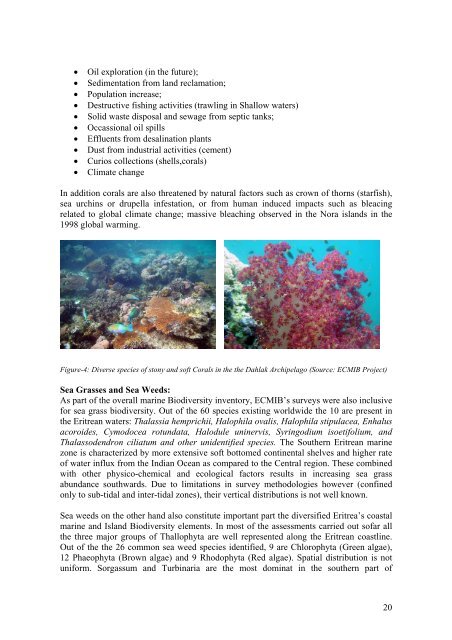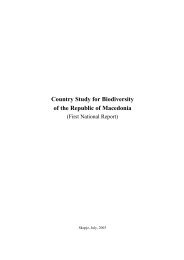English version - Convention on Biological Diversity
English version - Convention on Biological Diversity
English version - Convention on Biological Diversity
Create successful ePaper yourself
Turn your PDF publications into a flip-book with our unique Google optimized e-Paper software.
• Oil explorati<strong>on</strong> (in the future);<br />
• Sedimentati<strong>on</strong> from land reclamati<strong>on</strong>;<br />
• Populati<strong>on</strong> increase;<br />
• Destructive fishing activities (trawling in Shallow waters)<br />
• Solid waste disposal and sewage from septic tanks;<br />
• Occassi<strong>on</strong>al oil spills<br />
• Effluents from desalinati<strong>on</strong> plants<br />
• Dust from industrial activities (cement)<br />
• Curios collecti<strong>on</strong>s (shells,corals)<br />
• Climate change<br />
In additi<strong>on</strong> corals are also threatened by natural factors such as crown of thorns (starfish),<br />
sea urchins or drupella infestati<strong>on</strong>, or from human induced impacts such as bleacing<br />
related to global climate change; massive bleaching observed in the Nora islands in the<br />
1998 global warming.<br />
Figure-4: Diverse species of st<strong>on</strong>y and soft Corals in the the Dahlak Archipelago (Source: ECMIB Project)<br />
Sea Grasses and Sea Weeds:<br />
As part of the overall marine Biodiversity inventory, ECMIB’s surveys were also inclusive<br />
for sea grass biodiversity. Out of the 60 species existing worldwide the 10 are present in<br />
the Eritrean waters: Thalassia hemprichii, Halophila ovalis, Halophila stipulacea, Enhalus<br />
acoroides, Cymodocea rotundata, Halodule uninervis, Syringodium isoetifolium, and<br />
Thalassodendr<strong>on</strong> ciliatum and other unidentified species. The Southern Eritrean marine<br />
z<strong>on</strong>e is characterized by more extensive soft bottomed c<strong>on</strong>tinental shelves and higher rate<br />
of water influx from the Indian Ocean as compared to the Central regi<strong>on</strong>. These combined<br />
with other physico-chemical and ecological factors results in increasing sea grass<br />
abundance southwards. Due to limitati<strong>on</strong>s in survey methodologies however (c<strong>on</strong>fined<br />
<strong>on</strong>ly to sub-tidal and inter-tidal z<strong>on</strong>es), their vertical distributi<strong>on</strong>s is not well known.<br />
Sea weeds <strong>on</strong> the other hand also c<strong>on</strong>stitute important part the diversified Eritrea’s coastal<br />
marine and Island Biodiversity elements. In most of the assessments carried out sofar all<br />
the three major groups of Thallophyta are well represented al<strong>on</strong>g the Eritrean coastline.<br />
Out of the the 26 comm<strong>on</strong> sea weed species identified, 9 are Chlorophyta (Green algae),<br />
12 Phaeophyta (Brown algae) and 9 Rhodophyta (Red algae). Spatial distributi<strong>on</strong> is not<br />
uniform. Sorgassum and Turbinaria are the most dominat in the southern part of<br />
20
















